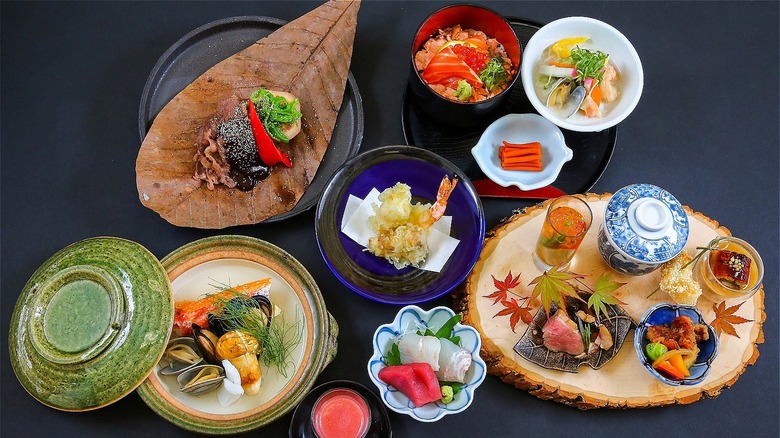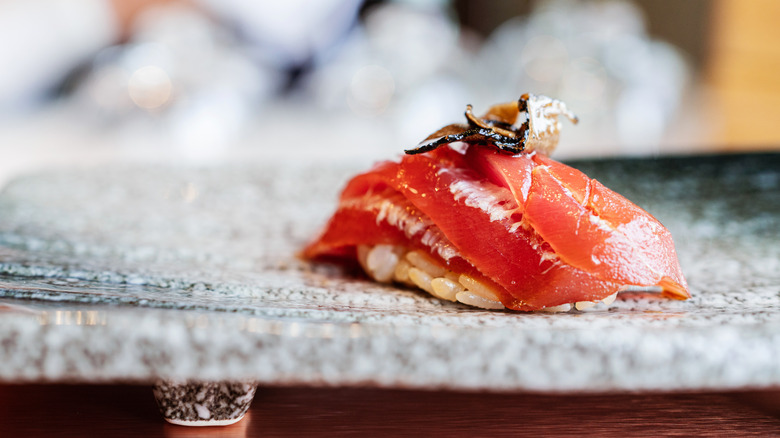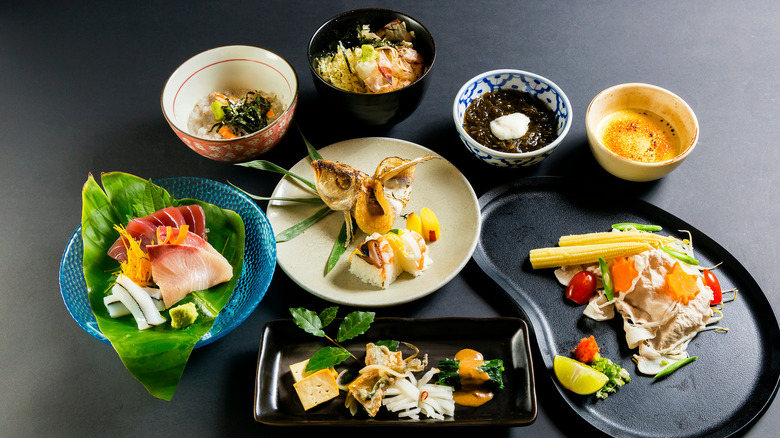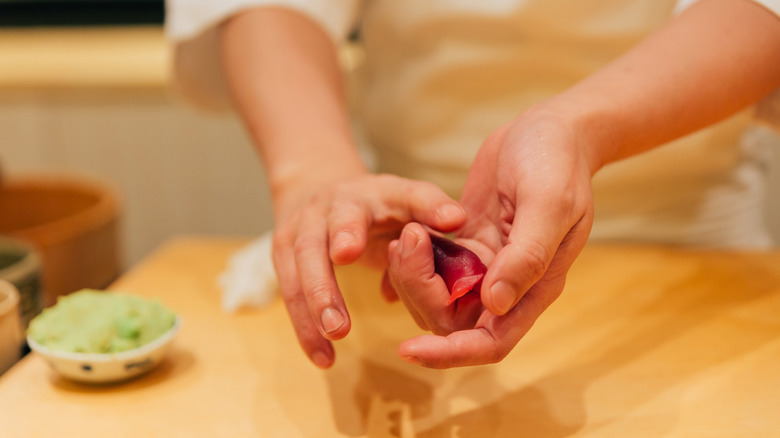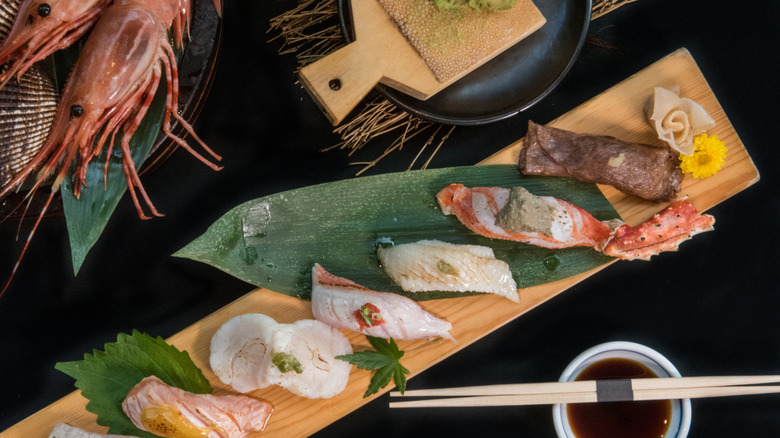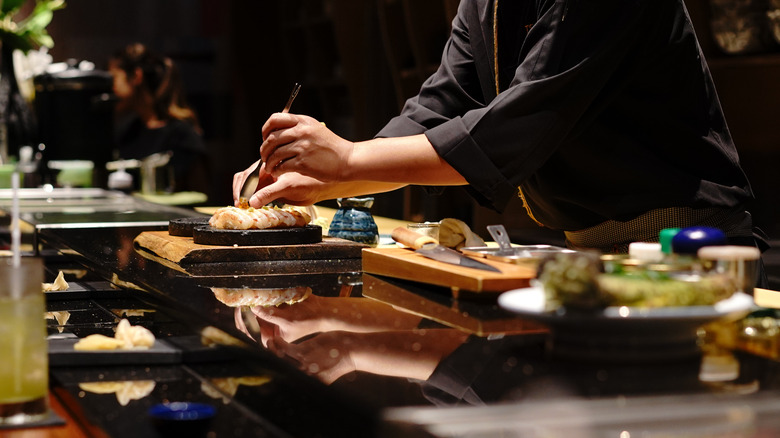Everything You Need To Know About Kaiseki
What comes to mind when thinking about the world's most spectacular dining experiences? Is it French cuisine with its rich sauces, foie gras, escargot, and butter-poached lobster? Maybe your mind wanders to molecular gastronomy and all its foams, technical specifications, and delectable edible treasures hidden beneath glass cloches obscured by swirling clouds of dry ice. Or, are you one of the many people who immediately think of Japanese fare, its breathtakingly detailed seasonal menus, brilliant knife work, and obsessive attention to detail?
Traditionally enjoyed on special occasions and renowned for its high level of quality and understated elegance, kaiseki is a form of "Japanese haute cuisine" according to Inside Kyoto. But what does that mean? And why is it so important to Japanese fine dining? Learn more about this impressive meal so that you'll know exactly what to expect, should you ever get the opportunity to enjoy one of Japan's most exquisite culinary achievements.
What is kaiseki?
Kaiseki is a time-honored style of Japanese dining that dates back to the 16th century, where it originated as a simple meal served alongside tea to Buddhist monks. According to Just One Cook, it is often referred to as kaiseki or cha-kaiseki. It has evolved quite a bit over the centuries, with tea master Sen no Rikyū being credited with its most austere version. Modern kaiseki is now seen as a type of cooking that is heavily focused on the quality of the ingredients, the skill and technique used to prepare the dishes, and the beauty and elegance of the presentation (per Inside Kyoto). It usually consists of six to 18 small courses of seasonal fish, vegetables, and poultry, and is described by the Ruth Reichl in the New York Times as adhering to "a strict order" of different tastes. These are intended to highlight the sweet, sour, salty, bitter, and pungent elements of the ingredients.
According to Eido T. Shimano, the abbot of the Zen Studies Society of New York, the purpose of kaiseki is to combine mindful Zen meditation with dining. "Tranquility and composure, reverence, respect, and purity are the key points," Shimano told the New York Times, "Basically to create a harmonious atmosphere."
The difference between omakase and kaiseki
Omakase is derived from the phrase, "omakase shimasu," which means "I trust you, chef." One of the world's most evocative types of dining, omakase allows for the full expression of a chef's artistry and skill. It gives the chef the creative freedom to choose what dishes the customer will eat based on what is fresh, available, and in season for the day (via Foodicles). Ideally, that means you never get the same meal twice, and the succession of each course is based on your reactions to the previous one. While most people think of omakase as it relates to sushi, you can find omakase experiences in restaurants that specialize in everything from robatayaki to yakitori and kushikatsu. It generally takes place in a small and intimate setting like a bar or counter, and diners can experience the anticipation as every dish is carefully prepared and imaginatively presented over a 12 to 20-course meal.
As Foodicles also notes, kaiseki alternatively features the most premium seasonal ingredients, and showcases not just the chef's artful cooking but also their plating prowess. The best kaiseki meals are defined by the serene experience and highlight the beauty, intricacy, thought, and effort behind each dish.
What to expect with kaiseki dining
Foodicles says a proper kaiseki meal will include at least nine courses, which encompass a bite-sized "sakizuke (amuse-bouche), hassun (seasonal course), suimono (a soup course, usually with a dashi broth base), mukōzuke (sashimi course), yakimono (grilled course), takiawase (simmered course), shokuji (rice course), and mizugashi or mizumono (sweets or fruits)." Expect to be served high end specialty ingredients such as fish liver, sea urchin, tuna, oysters, clams, and duck that are all expertly grilled, stewed, steamed, or served raw (per Savor Japan).
"This is not the Japanese junk food most Americans are familiar with, like tempura, teriyaki, sushi, and soba," according to a 1992 interview with Naoyuki Miyagawa, the executive chef of the Benkay Restaurant in San Francisco (via the New York Times). Other experts agree, including celebrity chef Wolfgang Puck, who had this to say, "It's the philosophy of kaiseki more than the actual tastes that have influenced me. In one evening, it will teach you everything there is to know about the Asian understanding of the relationship between eating and life."
Potential health benefits of kaiseki
BBC Good Food believes that the health benefits of Japanese cuisine contribute to the country's famously long life expectancy. Compared to French cuisine, with its rich sauces, butter poaching, and penchant for cooking things in duck fat, or the average American diet of large portions and love for red meat, its intrinsic healthiness is apparent (via Insider). Kaiseki is a thoughtful progression of things like pickled vegetables, plus raw, grilled, and steamed or stewed proteins. Largely devoid of saturated fats, modified carbohydrates, and processed sugars, it's one of the healthiest and heart-friendly cuisines you can consume (via Kobe Steak House).
Yet there are some who insist that one of the most highly prized benefits of the kaiseki experience is the connection to mental health and well-being through mindfulness. Zen master Shimano said it best when he told the New York Times, "That is the ultimate purpose of kaiseki ... that is the connection between kaiseki and karma. So many people don't remember that. They just go eat and say, 'Delicious.' But that's not the way. When I eat kaiseki, I consider it as if I'm going to practice meditation." It goes without saying that between the nutritional benefits and spiritual benefits, Kaiseki is well worth trying.
Where can you find kaiseki?
Highly coveted, and commonly considered the highest level of Japanese dining, kaiseki was not readily available outside of Japan until fairly recently. It's still an exclusive experience that, at least in the U.S., is primarily found in major cities, where it is served at mostly small and independent Japanese restaurants like the now-defunct Rosanjin in New York City (per Robb Report).
It's worth noting that it wasn't all that long ago when even basic sushi rolls were something that most Americans were unfamiliar with (via Food52). As Robb Report notes, supply chain issues related to importing fresh seafood from Japanese markets and a lack of awareness from the general public may have contributed to kaiseki remaining somewhat obscure. Currently, kaiseki menus can be found at high-end Japanese restaurants and in first-class hotels in cities such as Austin, Chicago, Atlanta, and San Francisco as well as many others nationwide (via Taste Atlas).
